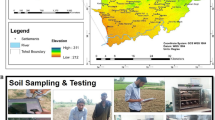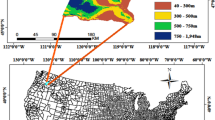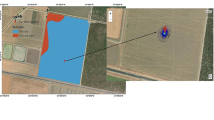Abstract
Soil temperature data are critical for understanding land–atmosphere interactions. However, in many cases, they are limited at both spatial and temporal scales. In the current study, an attempt was made to predict monthly mean soil temperature at a depth of 10 cm using artificial neural networks (ANNs) over a large region with complex terrain. Gridded independent variables, including latitude, longitude, elevation, topographic wetness index, and normalized difference vegetation index, were derived from a digital elevation model and remote sensing images with a resolution of 1 km. The good performance and robustness of the proposed ANNs were demonstrated by comparisons with multiple linear regressions. On average, the developed ANNs presented a relative improvement of about 44 % in root mean square error, 70 % in mean absolute percentage error, and 18 % in coefficient of determination over classical linear models. The proposed ANN models were then applied to predict soil temperatures at unsampled locations across the study area. Spatiotemporal variability of soil temperature was investigated based on the obtained database. Future work will be needed to test the applicability of ANNs for estimating soil temperature at finer scales.










Similar content being viewed by others
References
Beven K, Kirkby M (1979) A physically based, variable contributing area model of basin hydrology. Hydrol Sci Bull 24:43–69
Beven KJ, Wood EF (1983) Catchment geomorphology and the dynamics of runoff contributing areas. J Hydrol 65:139–158
Beven KJ, Wood EF, Sivapalan M (1988) On hydrological heterogeneity—catchment morphology and catchment response. J Hydrol 100:353–375
Bilgili M (2011) The use of artificial neural networks for forecasting the monthly mean soil temperatures in Adana Turkey. Turk J Agric For 35:83–93
Burrough PA (1986) Principles of geographical information systems for land resources assessment. Clarendon, Oxford
Chen et al (2002) Interpolation of wind-induced pressure time series with an artificial neural network. J Wind Eng Ind Aerodyn 90:589–615
Chiles JP, Delfiner P (1999) Geostatistics: modeling spatial uncertainty. Wiley, New York
Cooperative Research Group (2001). Chinese soil taxonomy. Science Press, Beijing-New York.
Daly C (2006) Guidelines for assessing the suitability of spatial climate data sets. Int J Climatol 26:707–721
George (2001) Prediction of soil temperature by using artificial neural networks algorithms. Nonlinear Anal 47:1737–1748
Goovaerts P (2000) Geostatistical approaches for incorporating elevation into the spatial interpolation of rainfall. J Hydrol 228:113–129
Hagan MT, Menhaj M (1994) Training feedforward networks with the Marquardt algorithm. IEEE Trans Neural Netw 5:989–993
Hu Q, Feng S (2003) A daily soil temperature dataset and soil temperature climatology of the contiguous United States. J Appl Meteorol 42:1139–1156
Isaaks EH, Srivastava RM (1989) An introduction to applied geostatistics. Oxford University Press, New York
Karnieli A, Bayasgalan M, Bayarjargal Y, Agam N, Khudulmur S, Tucker CJ (2006) Comments on the use of the vegetation health index over Mongolia. Int J Remote Sens 27:2017–2024
Karnieli A, Agam N, Pinker RT, Anderson MC, Mark L, Imhoff ML, Gutman GG, Panov N, Goldberg A (2009) Use of NDVI and land surface temperature for drought assessment: merits and limitations. J Climate 23:618–633
Kermani BG, Schiffman SS, Nagle HT (2005) Performance of the Levenberg–Marquardt neural network training method in electronic nose applications. Sensor Actuator B 110:13–22
Lam S (1983) Spatial interpolation methods: a review. Am Cartographer 10:129–149
Liu HB, Xie DT, Wu W (2008) Soil water content forecasting by ANN and SVM hybrid architecture. Environ Monit Assess 143:187–193
Ayres MP, MacLean SF Jr (1985) Estimation of soil temperature from climatic variables at Barrow, Alaska, U.S.A. Arctic Alpine Res 17:425–432
Meyers DE (1994) Spatial interpolation: an overview. Geoderma 62:17–28
Mihalakakou G (2002) On estimating soil surface temperature profiles. Energ Buildings 34:251–259
Moore ID, Grayson RB, Ladson AR (1991) Digital terrain modeling: a review of hydrological, geomorphologic and biological applications. Hydrol Process 5:3–30
Moore ID, Gessler PE, Nielsen GA, Peterson GA (1993) Terrain analysis for soil-specific crop management. In: Robert PC, Rust RC, Larson WE (eds) Proceedings of First Workshop, Soil Specific Crop Management. SSSA, Madison, pp 27–55
Ozturk M, Salman O, Koc M (2011) Artificial neural network model for estimating the soil temperature. Can J Soil Sci 91:551–562
Pan HL, Mahrt L (1987) Interaction between soil hydrology and boundary-layer development. Bound-Lay Meteorol 38:185–202
Picton P (2000) Neural networks, 2nd edn. Palgrave, New York
Quinn P, Beven K, Chevallier P, Planchon O (1991) The prediction of hillslope flow paths for distributed hydrological modeling using digital terrain models. Hydrol Process 5:59–79
Raquel B, Fernando M, Agustín R, Koldo O (2007) Geostatistical modelling of air temperature in a mountainous region of Northern Spain. Agric Forest Meteorol 146:173–188
Rouse JW, Haas RH, Schell JA, Deering DW (1973) Monitoring vegetation systems in the Great Plains with ERTS-1. In: Proceedings of 3rd earth resources technology satellite symposium, goddard space flight center, Washington, DC, 10–14 December 1973, Vol.1 pp 309–317
Seibert J, Bishop KH, Nyberg L (1997) A test of TOPMODEL’s ability to predict spatially distributed groundwater levels. Hydrol Process 11:1131–1144
Stumer et al (2010) Spatial interpolation of in situ data by self-organizing map algorithms (neural networks) for the assessment of carbon stocks in European forests. Forest Ecol Manag 260:287–293
Tabari H, Sabziparvar AA, Ahmadi M (2011) Comparison of artificial neural network and multivariate linear regression methods for estimation of daily soil temperature in an arid region. Meteorol Atmos Phys 110:135–142
Webster R, Oliver A (1992) Sample adequately to estimate variograms of soil properties. J Soil Sci 43:177–192
Wu W, Fan Y, Wang ZY, Liu HB (2008) Assessing effects of digital elevation model resolutions on soil-landscape correlations in a hilly area. Agric Ecosyst Environ 126:209–216
Xu WX, Gu S, Zhao XQ, Xiao JS, Tang YH, Fang JY, Zhang J, Jiang S (2011) High positive correlation between soil temperature and NDVI from 1982 to 2006 in alpine meadow of the Three-River Source Region on the Qinghai-Tibetan Plateau. Int J Appl Earth Obs 13:528–535
Yonaba H, Anctil F, Fortin V (2010) Comparing sigmoid transfer functions for neural network multistep ahead streamflow forecasting. J Hydrol Eng 15:275–283
Zheng DL, Hunt ER Jr, Running SW (1993) A daily soil temperature model based on air temperature and precipitation for continental applications. Clim Res 2:183–191
Acknowledgments
This research was funded by Science and Technology Projects of China National Tobacco Corporation (CNTC) Chongqing companies (NY20110601070002), Natural Science Foundation Project of CQ CSTC (2010BB1008), and Scientific Research Foundation for the Returned Overseas Chinese Scholars (2010-1174).
Author information
Authors and Affiliations
Corresponding author
Rights and permissions
About this article
Cite this article
Wu, W., Tang, XP., Guo, NJ. et al. Spatiotemporal modeling of monthly soil temperature using artificial neural networks. Theor Appl Climatol 113, 481–494 (2013). https://doi.org/10.1007/s00704-012-0807-7
Received:
Accepted:
Published:
Issue Date:
DOI: https://doi.org/10.1007/s00704-012-0807-7




